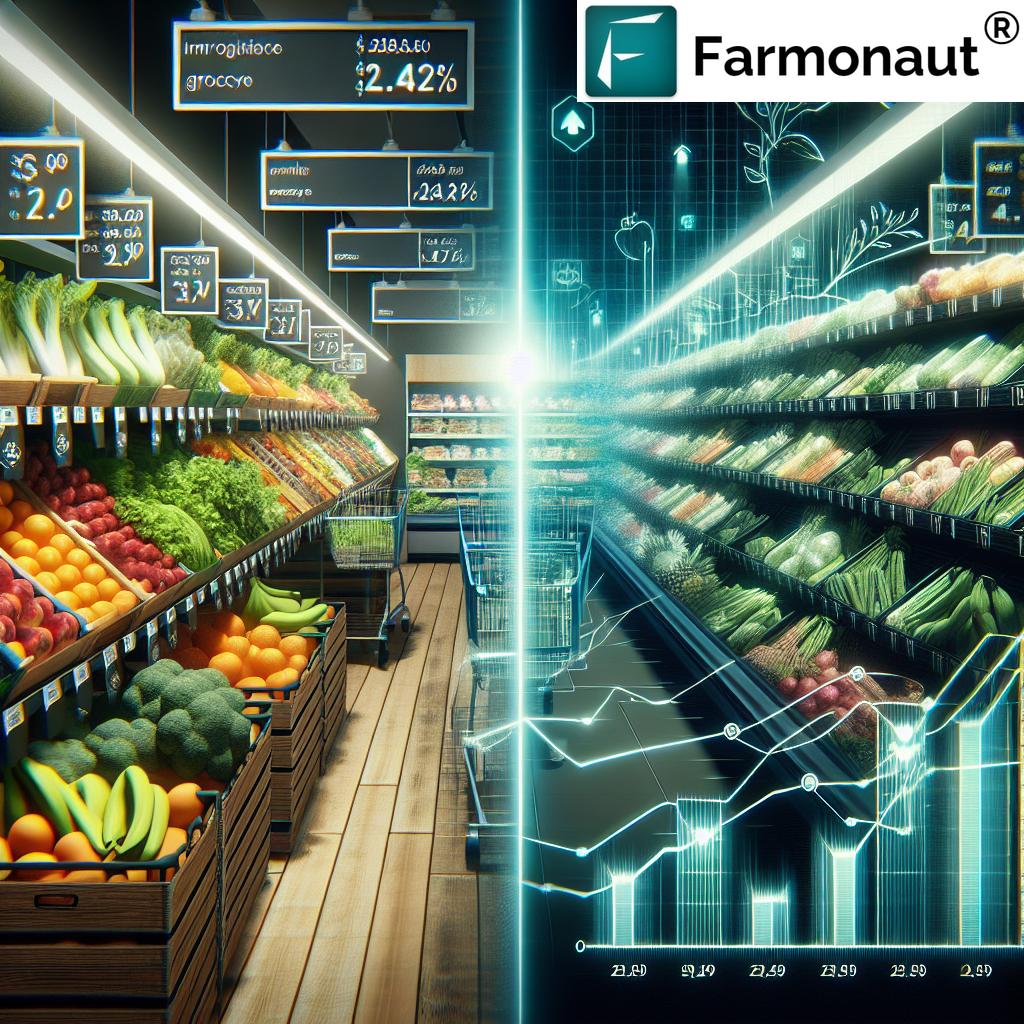2023 Tariff Impact: How Mexico and Canada Trade Policies Affect US Grocery Prices and Agricultural Imports

“The 2023 tariffs impact billions in US agricultural imports, potentially raising costs for everyday grocery essentials.”
In the ever-evolving landscape of international trade, we find ourselves at a crucial juncture as we analyze the far-reaching implications of the Trump tariffs on Mexico and Canada. The year 2023 has ushered in a new era of trade policies that are set to reshape the agricultural sector and impact consumer experiences across the United States. As we delve into this complex issue, we’ll explore how these tariffs are affecting US grocery prices, energy costs, and the broader economic landscape.
Understanding the 2023 Tariff Landscape
The recent implementation of significant tariffs on goods imported from Mexico, Canada, and China marks a cornerstone of the Trump administration’s trade policy. These measures include a 25% levy on imports from Mexico and Canada, alongside a 10% tariff on goods coming from China. The primary aim of these policies is to bolster domestic production, but they come with potential consequences that extend far beyond the borders of international commerce.
In 2023, the United States imported over $45 billion worth of agricultural products from Mexico and an additional $40 billion from Canada. These figures underscore the integral nature of these trade relationships to the American economy, particularly in the agricultural sector. As we witness the unfolding of these new tariffs, it’s crucial to understand their potential impact on various aspects of our daily lives.
The Ripple Effect on US Grocery Prices
One of the most immediate and tangible effects of the new tariffs is likely to be felt in the grocery aisles across America. As the cost of imported goods rises, consumers may soon experience a noticeable increase in their grocery bills. This concern is echoed by local residents like Ally Stein from Union, who expressed difficulties in managing finances as various expenses, including gas and oil, continue to add up.
Let’s break down how these tariffs might affect different categories of agricultural imports:
- Fruits and Vegetables: Mexico is a major supplier of fresh produce to the US. With the new tariffs, we could see price hikes on items like avocados, tomatoes, and berries.
- Dairy Products: Canada is a significant source of dairy imports. The tariffs may lead to increased prices for cheese, butter, and other dairy products.
- Grains and Cereals: While the US is a major grain producer, certain specialty grains and cereals from Canada might become more expensive.
- Processed Foods: Many processed foods contain ingredients sourced from Mexico or Canada. The tariffs could lead to higher prices for these convenience items.
Impact on Energy and Fuel Costs
Beyond the grocery store, the new tariffs are poised to affect energy and fuel costs. As imports of oil and gas from Canada become more expensive, we may see a rise in energy prices across the board. This could have a cascading effect on various sectors of the economy, potentially leading to increased transportation costs and, consequently, higher prices for a wide range of goods.
The interplay between agricultural imports and energy costs is particularly noteworthy. As fuel prices rise, the cost of transporting agricultural products within the US could also increase, further contributing to higher food prices for consumers.
Trade Policy Effects on Consumers
The impact of these tariffs extends beyond mere numbers on price tags. We’re witnessing a shift in consumer behavior and concerns about food quality. James Tomasso, reflecting on his agricultural upbringing, noted the potential shift in food quality due to these tariffs. He observed that while he personally does not prefer unpasteurized milk, the current trajectory of trade might lead consumers toward lower-quality options that are less regulated because of increased prices for higher-quality imports.
This sentiment highlights a critical aspect of the tariff impact: the potential compromise on food quality and safety standards. As consumers face higher prices for imported goods, there’s a risk that they might opt for cheaper, potentially less regulated alternatives. This shift could have long-term implications for public health and food safety standards in the US.
“Recent trade policy shifts with Mexico, Canada, and China could significantly affect US grocery bills and energy costs.”
US-Canada Trade Relations in the Spotlight
The relationship between the United States and Canada has long been characterized by close economic ties, particularly in the agricultural sector. The implementation of these new tariffs puts this relationship under significant strain. We’re seeing a reevaluation of long-standing trade agreements and a potential reshaping of the North American agricultural landscape.
Key aspects of US-Canada trade relations affected by the 2023 tariffs include:
- Dairy Trade: The dairy industry has been a contentious issue in US-Canada trade relations. The new tariffs could exacerbate tensions in this sector.
- Lumber and Wood Products: Canada is a major supplier of lumber to the US. The tariffs could impact construction costs and related industries.
- Agricultural Technology Exchange: The flow of agricultural technology and innovations between the two countries might be affected, potentially slowing advancements in farming practices.
Explore Farmonaut’s API for agricultural insights
Economic Impact of Trade Tariffs
The economic ramifications of these tariffs are far-reaching and complex. While the primary goal is to protect and promote domestic industries, the potential for unintended consequences is significant. Here’s a closer look at some of the economic impacts:
- Job Market Fluctuations: While some domestic industries might see growth, others that rely heavily on imports could face challenges, potentially leading to job losses in certain sectors.
- Inflation Concerns: As the cost of goods increases, there’s a risk of inflationary pressure on the overall economy.
- Trade Deficit Shifts: The tariffs aim to reduce the trade deficit, but the actual outcome remains to be seen, especially considering potential retaliatory measures from affected countries.
- Agricultural Sector Adaptation: US farmers may need to adapt to new market conditions, potentially shifting their crop choices or seeking new export markets.
The Role of Technology in Navigating Trade Challenges
In the face of these trade challenges, technology plays a crucial role in helping farmers and agricultural businesses adapt. Companies like Farmonaut are at the forefront of this technological revolution in agriculture. By leveraging satellite imagery, AI, and blockchain technology, Farmonaut provides valuable tools for farmers to optimize their operations in this changing economic landscape.
Some key technologies helping farmers navigate these challenges include:
- Satellite-Based Crop Monitoring: Helps farmers make data-driven decisions to maximize yield and efficiency.
- AI-Driven Advisory Systems: Provide personalized recommendations based on real-time data and market conditions.
- Blockchain for Supply Chain Transparency: Enhances traceability and helps maintain quality standards in the face of changing import dynamics.
Consumer Concerns About Food Quality
As we navigate this new tariff landscape, consumer concerns about food quality have come to the forefront. The potential for reduced access to high-quality imported products raises questions about food safety and nutritional standards. Here are some key points to consider:
- Shift in Product Origins: Consumers may see changes in where their food comes from, potentially affecting quality and variety.
- Regulatory Standards: There’s concern about whether domestic producers can maintain the same quality standards as established international suppliers.
- Organic and Specialty Products: The availability and affordability of organic and specialty imported products may be particularly affected.
- Food Safety Measures: Ensuring robust food safety measures for domestic products becomes even more critical as reliance on imports decreases.
The Dairy Dilemma: A Case Study in Tariff Impact
The dairy industry serves as a prime example of how these tariffs are reshaping agricultural trade. With significant imports from Canada, the US dairy market is particularly sensitive to these new trade policies. The tariffs could lead to:
- Increased prices for imported dairy products
- Potential growth opportunities for domestic dairy farmers
- Shifts in consumer preferences towards domestic dairy options
- Challenges for processors who rely on imported dairy ingredients
The case of unpasteurized milk, mentioned by James Tomasso, highlights the complexities of these trade dynamics. While food safety regulations in the US generally prohibit the sale of unpasteurized milk, the discussion around it underscores the broader concerns about food quality and regulatory standards in a changing trade landscape.
Rising Energy Costs Due to Tariffs
The impact of tariffs on energy costs is a critical aspect of this trade policy shift. As mentioned earlier, the US imports significant amounts of oil and gas from Canada. The new tariffs could lead to:
- Higher prices for gasoline and heating fuels
- Increased costs for energy-intensive industries
- Potential acceleration of the shift towards renewable energy sources
- Challenges for consumers already struggling with rising living costs
These rising energy costs have a ripple effect throughout the economy, potentially impacting everything from transportation to manufacturing, and ultimately, the prices consumers pay for goods and services.
Estimated Impact of 2023 Tariffs on US Agricultural Imports and Consumer Prices
| Product Category | Pre-Tariff Import Value (USD) | Estimated Tariff Increase (%) | Projected Consumer Price Impact (%) |
|---|---|---|---|
| Dairy Products | $2.5 billion | 25% | 15-20% |
| Fresh Fruits | $7 billion | 25% | 10-15% |
| Vegetables | $6.5 billion | 25% | 12-18% |
| Grains | $3 billion | 25% | 8-12% |
| Meat Products | $4 billion | 25% | 15-22% |
Note: These figures are estimates based on current trade data and projected impacts. Actual effects may vary due to market dynamics and other economic factors.
Adapting to the New Trade Reality
As we navigate this new trade landscape, adaptation becomes key for both consumers and producers. Here are some strategies being employed:
- Diversification of Supply Chains: Businesses are looking to diversify their supply sources to mitigate the impact of tariffs on specific countries.
- Investment in Domestic Production: There’s increased focus on enhancing domestic agricultural production to reduce reliance on imports.
- Technology Adoption: Farmers and food processors are increasingly turning to technology solutions to improve efficiency and reduce costs.
- Consumer Education: There’s a growing need for consumer education about the origins and quality of food products in light of these trade changes.
Check out Farmonaut’s API Developer Docs for agricultural data integration
The Role of Farmonaut in the Changing Agricultural Landscape
In these challenging times, technology plays a crucial role in helping farmers adapt and thrive. Farmonaut, a leading agricultural technology company, offers innovative solutions that are particularly relevant in the context of these trade policy shifts:
- Satellite-Based Crop Health Monitoring: Helps farmers optimize crop yields and reduce resource wastage, crucial for maintaining competitiveness in a changing market.
- AI Advisory System: Provides real-time insights and expert crop management strategies, helping farmers make informed decisions in response to market changes.
- Blockchain-Based Traceability: Enhances transparency in supply chains, which is increasingly important as consumers become more conscious about the origin and quality of their food.
- Resource Management Tools: Aids in efficient management of agricultural resources, helping farmers maintain profitability in the face of potential price pressures.
By leveraging these technologies, farmers can better navigate the challenges posed by the new tariff landscape, potentially mitigating some of the negative impacts on both production costs and consumer prices.
Looking Ahead: The Future of US Agricultural Trade
As we look to the future, several key trends and questions emerge:
- Potential for Policy Adjustments: Will there be modifications to these tariffs in response to economic impacts?
- Technological Innovation: How will advancements in agricultural technology shape the industry’s response to these trade challenges?
- Consumer Behavior Shifts: Will we see long-term changes in consumer preferences and buying habits as a result of these tariffs?
- Global Trade Dynamics: How will these US policies affect global agricultural trade patterns and relationships?
Earn With Farmonaut: Join our Affiliate Program
Earn 20% recurring commission with Farmonaut’s affiliate program by sharing your promo code and helping farmers save 10%. Onboard 10 Elite farmers monthly to earn a minimum of $148,000 annually—start now and grow your income!
Conclusion: Navigating the Complex Interplay of Trade and Agriculture
The 2023 tariffs on imports from Mexico, Canada, and China represent a significant shift in US trade policy, with far-reaching implications for the agricultural sector and consumer experiences. As we’ve explored, these changes are likely to impact grocery prices, energy costs, and the broader economic landscape.
While the full extent of these impacts is still unfolding, it’s clear that adaptability and innovation will be key in navigating this new reality. Farmers, consumers, and businesses alike will need to stay informed and leverage available technologies and strategies to mitigate challenges and capitalize on opportunities.
As we move forward, the balance between supporting domestic industries and managing consumer costs will remain a critical consideration. The agricultural sector, in particular, will play a pivotal role in shaping how these trade policies translate into everyday experiences for American consumers.
In this evolving landscape, staying informed and adaptable will be crucial. We’ll continue to monitor these developments and provide insights into how they shape the future of agriculture and consumer experiences in the United States.
FAQ Section
- Q: How will the 2023 tariffs affect my grocery bills?
A: The tariffs are likely to increase prices for various imported foods, potentially leading to higher overall grocery costs. The exact impact will vary depending on the specific products and their origin. - Q: Will these tariffs affect the quality of food available in the US?
A: There are concerns that higher prices for imported goods might lead consumers to opt for cheaper, potentially lower-quality alternatives. However, this also presents an opportunity for domestic producers to step up and meet quality standards. - Q: How might these tariffs impact US farmers?
A: US farmers may face both challenges and opportunities. While they might benefit from reduced competition from imports, they could also face higher costs for farm inputs and potential retaliation in export markets. - Q: Are there any positive aspects to these new tariffs?
A: Proponents argue that the tariffs could boost domestic production and create jobs in certain sectors. However, the overall economic impact is complex and multifaceted. - Q: How long are these tariffs expected to remain in place?
A: The duration of these tariffs is uncertain and may depend on various political and economic factors. It’s a situation that will likely evolve over time.

















